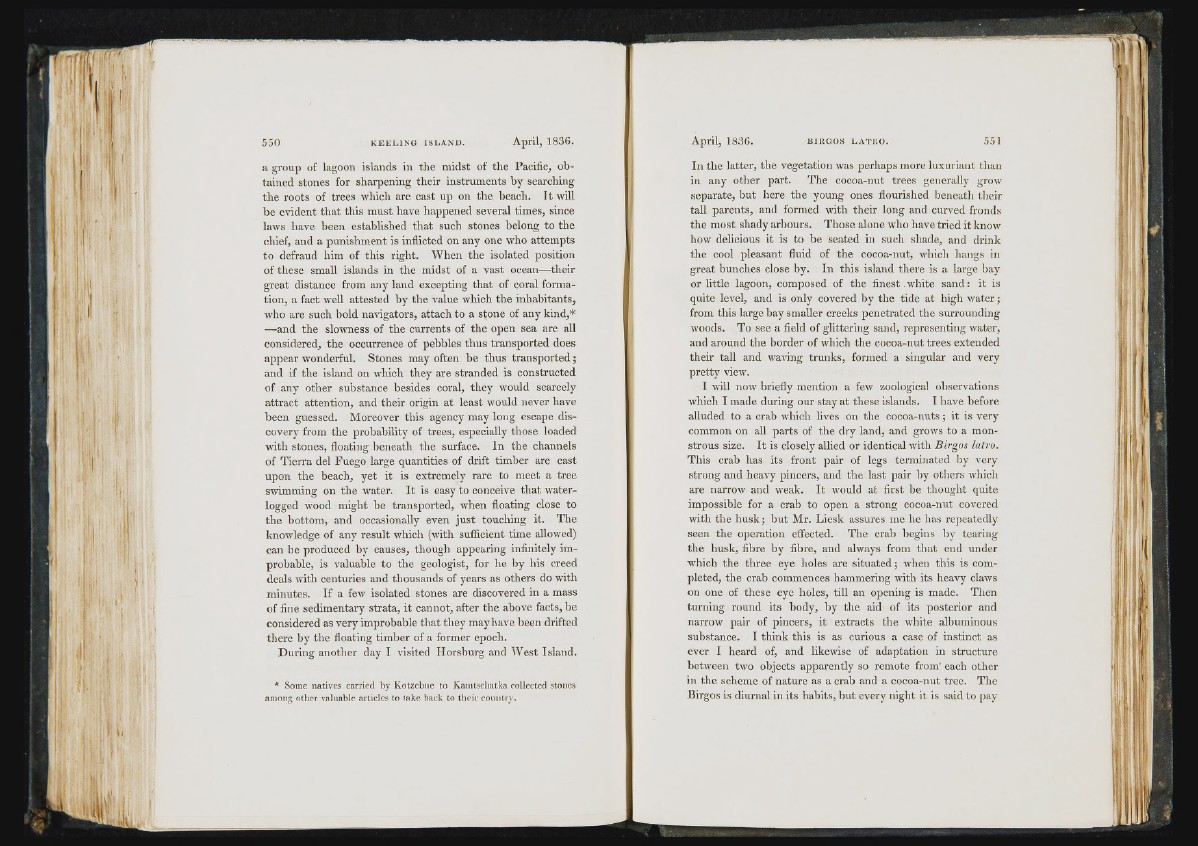
! u
550 KE E L ING I S LAND. April, 1836.
a group of lagoon islands in the midst of the Pacific, obtained
stones for sharpening their instruments by searching
the roots of trees which are cast up on the beach. It will
he evident that this must have happened several times, since
laws have been established that such stones belong to the
chief, and a punishment is inflicted on any one who attempts
to defraud him of this right. When the isolated position
of these small islands in the midst of a vast ocean—their
great distance from any land excepting that of coral formation,
a fact well attested by the value which the mhabitants,
who are such bold navigators, attach to a stone of any kind,*
—and the slowness of the currents of the open sea are all
considered, the occurrence of pebbles thus transported does
appear wonderful. Stones may often he thus transported;
and if the island on which they are stranded is constructed
of any other substance besides coral, they would scarcely
attract attention, and their origin at least would never have
been guessed. Moreover this agency may long escape discovery
from the probability of trees, especially those loaded
with stones, floating beneath the surface. In the channels
of Tierra del Fuego large quantities of drift timber are cast
upon the beach, yet it is extremely rare to meet a tree
swimming on the water. It is easy to conceive that waterlogged
wood might be transported, when floating close to
the bottom, and occasionally even just touching it. The
knowledge of any result which (with sufficient time allowed)
can be produced by causes, though appearing infinitely improbable,
is valuable to the geologist, for he by his creed
deals with centuries and thousands of years as others do with
minutes. If a few isolated stones are discovered in a mass
of fine sedimentary strata, it cannot, after the above facts, be
considered as very improbable that they may have been drifted
there by the floating timber of a former epoch.
During another day I visited Horsburg and West Island.
* Som e n a tiv e s c a rrie d by K o tz e b u e to K a in ts c lm tk a co lle c te d sto n e s
am o n g o th e r v a lu a b le a rtic le s to tak e b a ck to th e ir c o u n try .
April, 1836. B I R G O S LA T I i O . 551
In the latter, the vegetation was perhaps more luxuriant than
in any other part. The cocoa-nut trees generally grow
separate, but here the young ones flourished beneath their
tall parents, and formed with their long and curved fronds
the most shady arbours. Those alone who have tried it know
how delicious it is to be seated in such shade, and drink
the cool pleasant fluid of the cocoa-nut, which hangs in
great bunches close by. In this island there is a large bay
or little lagoon, composed of the finest white sand: it is
quite level, and is only covered by the tide at high water;
from this large bay smaller creeks penetrated the surrounding
woods. To see a field of glittering sand, representing water,
and around the border of which the cocoa-nut trees extended
their tall and waving trunks, formed a singular and very
pretty view.
I will now briefly mention a few zoological observations
which I made during our stay at these islands. I have before
alluded to a crab which lives on the cocoa-nuts; it is very
common on all parts of the dry land, and grows to a monstrous
size. It is closely allied or identical with Birgos latro.
This crab has its front pair of legs terminated by very
strong and heavy pincers, and the last pair by others which
are narrow and weak. It would at first be thought quite
impossible for a crab to open a strong cocoa-nut covered
with the husk; but Mr. Liesk assures me he has repeatedly
seen the operation effected. The crab begins by tearing
the husk, fibre by fibre, and always from that end under
which the three eye holes are situated; when this is completed,
the crab commences hammering with its heavy claws
on one of these eye holes, till an opening is made. Then
turning round its body, by the aid of its posterior and
narrow pair of pincers, it extracts the white albuminous
substance. I think this is as curious a case of instinct as
ever I heard of, and likewise of adaptation in structure
between two objects apparently so remote from" each other
in the scheme of nature as a crab and a cocoa-nut tree. The
Birgos is diurnal in its habits, but every night it is said to pay
Iiil